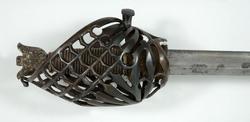Current Location: Gallery 31 (Armoury)
Titles
Schiavona
Maker(s)
Production:
Unknown
Entities
Categories
Description
Large, silver-gilt, pommel of 'lat'o head' or shield-shaped form, showing on each face in high relief a trophy of arms surrounding a drum flanked by two prancing putti. Large, stout grip of oval section swelling towards the lower end, bound with alternating strands of brass and silver wire. Basket guard of steel, retaining its original blackened colour (of Schiavona type B in the Oakeshott typology of hilts). The roughly-chiselled troop-mask M:C + appears on the outside of one of the bars of the back-guards. The ricasso retains its original sleeve of canvas. This is stitched with gold thread in diagonal ribs with a looped and scalloped lower edge.
Blade of flat oval section, with a short, shallow fuller at the forte. This fuller is outlined with incised lines, forming a panel which ends in a peaked final surmounted by a cross. There are marks, high under the sleeve on one side: E+. The original scabbard survives. This is made of slats of thin wood covered by leather, now black but once brown or red. There is a very elaborate chape of silver (once gilt?) elaborately decorated with pierced patterns surmounted by an Imperial double-headed eagle. Up from the chape, on each edge of the scabbard, is a gutter-shaped silver mount. The edges run two-thirds of the way up, and are secured at intervals by four transverse bands of silver, two of which are close together at the top. From the mouth of the scabbard, on the outside under the leather covering is a sharp ridge to hold the belt-fitting in place and to prevent it from slipping.
Notes
History note: Mr James Stewart Henderson of 'Abbotsford', Downs Road, St Helen's Park, Hastings, Sussex
Legal notes
J.S. Henderson Bequest
Measurements and weight
Length: 122 cm
Acquisition and important dates
Method of acquisition: Bequeathed
(1933-03-16)
by
Henderson, James Stewart
Dating
18th Century, Late
Circa
1770
CE
-
1790
CE
Note
Many of the Schiavona hilts have troop or actual numbers engraved upon one of the back-guards, as does the example here. Some confusion has arisen because two of the hilts (Royal Armouries at the Tower of London and in the Museum in Edinburgh) bear the numerals 1781 and 1780. They have always been assumed to be dates. However, a Schiavona sold at Christie's on April 14th, 1966 (lot 152) has the 'date' 1561. It also has the letters on the back-guard, M.C. as does the one in the Tower. It is not possible to believe that the 'date' of 1561 can apply to one of these late Schiavona hilts; but the matter is finally resolved by the fact that the 'date' on the Solingen sword is 1909. So these are clearly numbers, not dates.
This is an outstanding example of a type of long cavalry sword used by Slavonic (hence its roriquet 'Schiavona') mercenary troops, often Hungarian, in the pay of the Venetian Republic. (For a full description of the swords, with a typological sequence, see Oakeshott, E. European Weapons and Armour, London, 1980). There are in Britain three similar swords in the same complete state of preservation - one in the Tower of London (Inv. No. IX-917), one in the Victoria and Albert Museum, and one in the Royal Scottish Museum in Edinburgh, while a fourth is in the Khugenmuseum in Solingen. Though as complete, with their scabbards, none of these is as fine a specimen as the Fitzwilliam Museum's Schiavona.
This type of basket-hilted sword was popular in Italy in the 16th and 17th centuries. It is based on the type of sword carried by Balkan mercenaries who formed the bodyguard of the Doge of Venice which consisted largely of Istrian and Dalmatian Slavs – called in Italy, schiavoni. It was also popular among the armies trading with Italy during the 17th century and widely used by the heavy cavalry and also with wealthy citizens who wore highly decorated examples as both a fashion accessory and a defensive weapon.
People, subjects and objects depicted
Components of the work
Stitching
composed of
thread
( gold)
Grip
composed of
silver
( wire)
brass (alloy)
( wire)
Scabbard
composed of
wood (plant material)
leather
Ricasso Sleeve
composed of
canvas
Chape
composed of
silver
Scabbard Mounts
composed of
silver
Basket-guard
composed of
steel
Sword
composed of
steel
Blade
Length 99 cm
Blade At Hilt
Width 3.5 cm
Basket Guard
Decoration
Fuller
Inscription or legends present
- Text: E+
- Location: Under the sleeve of fuller
- Method of creation: Inscribed
- Type: Mark
References and bibliographic entries
Identification numbers
Accession number: HEN.M.296 & A-1933
Primary reference Number: 19123
Old object number: B347
Stable URI
Audit data
Created: Saturday 6 August 2011
Updated: Tuesday 30 April 2024
Last processed: Tuesday 13 May 2025
Associated departments & institutions
Owner or interested party:
The Fitzwilliam Museum
Associated department:
Applied Arts

 IIIF Manifest
IIIF Manifest








